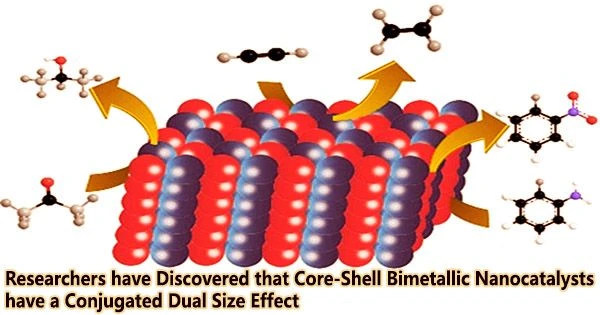The conjugated dual size effect of core-shell bimetallic nanocatalysts was recently discovered by a team lead by Professor Lu Junling working with Professors Li Weixue and Wei Shiqiang. The team found that the catalysts’ activity increased with core size in the benzyl alcohol oxidation reaction. Their work was published in Nature Communications.
Due to their bimetallic synergy, which varies with compositions and architectures, bimetallic catalysts are frequently used in many chemical synthesis processes. The distinctive lattice stresses and ligand effects of core-shell catalysts, as opposed to alloy catalysts, can maximize the geometric and electrical properties.
Because the ligand effects and charge transfers between the components typically take place at the core-shell contact, the thickness of the shell has a substantial impact on bimetallic synergy.
Lattice mismatch between the metal core and the shell causes lattice strains in core-shell catalysts, which have a significant impact on the electronic structure of the metal shell and the overall activity of catalysts.
Reduced core size causes the lattice of the core to decrease significantly, which changes how well it matches the lattice of the shell and, as a result, alters the lattice strains in the shell. As a result of the enormous difficulty in altering the core size and shell thickness at the atomic level, this dual size impact of core-shell particles has not yet been investigated.
To solve these difficulties, the three teams chose solvent-free selective oxidation of benzyl alcohol (BzOH) as probe reaction, and revealed the dual size effect of Au@Pd catalyst using atomic layer deposition, multi-spectroscopy and density functional theory (DFT) calculations.
The theoretical calculations conducted by Prof. Li Weixue’s team showed that the lattices of Pd overlayer on Au particles expand and tend to enhance BzOH adsorption, while a reduced Au core size would reduce the strains on the Pd shell.
When the Pd shell thickness reached 2 monolayers (ML) and higher, the ligand effects of the Au core could become insignificant, according to additional simulations. Hence, a big Au core enclosed in a 2 ML thick Pd shell will yield the most adsorption energy.
To experimentally examine the dual size effect, Prof.LU Junling’s team first synthesized Au/SiO2 catalysts with different Au sizes and executed Pd ALD to yield Pd shells with varying thickness on Au particles at atomic level.
The scientists then used X-ray diffraction (XRD) and transmission electron microscopy (TEM) to highlight the evolution of the atomic and electronic structure of Au and Pd in the core-shell structure with the Au core size.
Findings indicated that the activity of catalysts rose with Pd shell thickness quickly and peaked at 2.9ML before it started to decline in the oxidation of BzOH with a fixed Au core size.
With a fixed Pd shell thickness, the activity also improved with increasing core size. The team achieved a maximum activity higher than previous studies in Au6.8@2.9ML-Pd catalyst.
The hydrogenation of para-chloronitrobenzene (p-CNB) revealed a similar conjugated result, demonstrating the phenomenon’s universality. Significant guidelines for the future creation of highly effective bimetallic catalysts were supplied by this work.















